|
Beauty and Strength
from Paper
by Bob Brooke
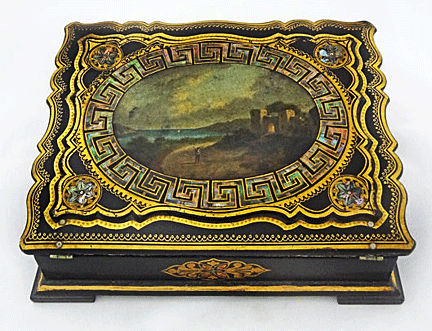 When
someone says papier-maché today, most people think back to the days in
school art classes when they soaked strips of paper in mixture of flour
and water and made a variety of shapes, including puppet heads and
fruit, and weird sculptures. But papier-maché had a much more elegant
past that’s little known today. During the early 19th century, every
household had a least one useful object made of papier-maché. When
someone says papier-maché today, most people think back to the days in
school art classes when they soaked strips of paper in mixture of flour
and water and made a variety of shapes, including puppet heads and
fruit, and weird sculptures. But papier-maché had a much more elegant
past that’s little known today. During the early 19th century, every
household had a least one useful object made of papier-maché.
The Chinese invented papier-maché soon after they invented paper in the
second century. In Europe the industry developed in France in the 1650s
with small decorative objects, such as boxes made of used paper gathered
during the night by billboard strippers. By the early 1760s, Germany had
its first papier-maché factory. Russia gained world renown for its
lovely hand-painted papier-maché boxes, decorated with landscapes,
peasants and scenes taken from Russian folklore.
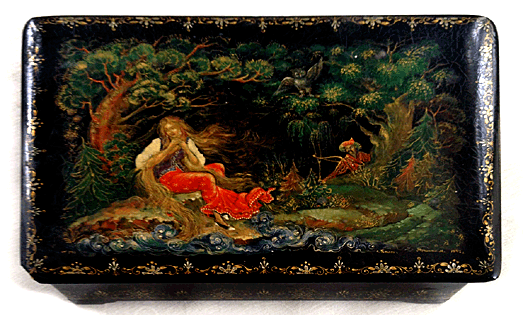
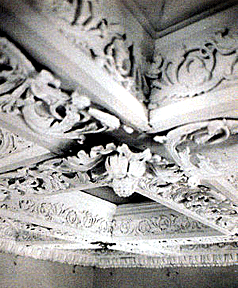 The
term papier-maché is French and means crushed paper. Papier-maché
consists of several layers of thick damp paper and vegetable matter
pressed together into sheets in an iron mold and then oven dried. After
workers took it out of the mold, they coated it with multiple coats of
varnish—a process called “japanning,” thus waterproofing it and making
it ready for decoration. After artists decorated the item, they applied
a final coat of clear varnish to protect it. The
term papier-maché is French and means crushed paper. Papier-maché
consists of several layers of thick damp paper and vegetable matter
pressed together into sheets in an iron mold and then oven dried. After
workers took it out of the mold, they coated it with multiple coats of
varnish—a process called “japanning,” thus waterproofing it and making
it ready for decoration. After artists decorated the item, they applied
a final coat of clear varnish to protect it.
In England the papier-maché industry quickly followed the introduction
of paper making around 1690. At first people used the pulped paper for
interior decoration and architectural ornaments because it was a less
expensive than other building materials. Then they applied it to picture
and looking glass frames and small ornamental moldings. By 1766, John
Taylor of Birmingham had begun to make buttons and snuff boxes.
Papier-maché Panels
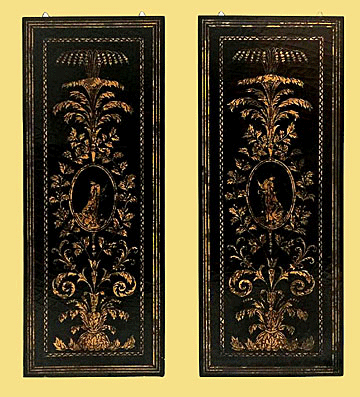 n
1772 Henry Clay, also of Birmingham, patented a process for making
heat-resistant, hand-smoothed panels of papier-maché. These stronger
panels could be sewn and dovetailed just like real wood and were perfect
for making furniture. n
1772 Henry Clay, also of Birmingham, patented a process for making
heat-resistant, hand-smoothed panels of papier-maché. These stronger
panels could be sewn and dovetailed just like real wood and were perfect
for making furniture.
Clay pasted 10 sheets of unsized rag paper on both sides with a mixture
of cooked glue and flour. He then pressed this into a metal mold,
smoothing it to remove air bubbles. Finally, he trimmed the edges and
drenched the sheets with linseed oil for waterproofing. Lastly, he dried
the panels at 1000° F.
The result was a rigid material that could be worked like wood. The use
of paper panels came to be known as the "best" papier-mache as opposed
to the common papier-mâché made from pulp.
Clay first used this new material for panels on sedan chairs and
coaches, where lightness was critical. Next, Clay also used his new
panels to manufacture trays. Tea trays, in particular, were the main
item produced in great numbers, thanks to the spread of tea drinking
among the English middle class. Unfortunately, his patents ran out in
1802.
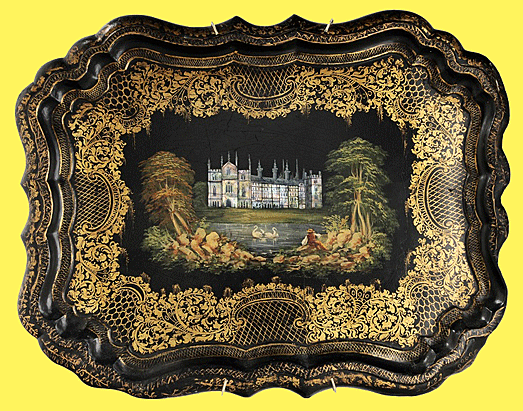
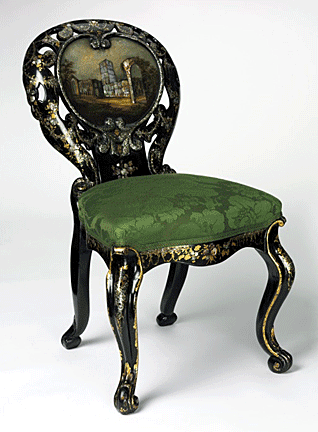 n
1816, Aaron Jennens and T.H. Bettridge purchased Clay’s factory, which
had become the top producer of high quality papier-maché. Jennens
developed a technique in which panels could be softened with steam to
enable manipulation into a heated metal mold. Workers then screwed a
counter mold into position and heat-dried the steam-molded panels. The
result was a hard, pre-shaped product of even thickness. By reducing the
number of steps and the amount of time required to mold furniture,
Jennens revolutionized the process and opened the door to
mass-production. n
1816, Aaron Jennens and T.H. Bettridge purchased Clay’s factory, which
had become the top producer of high quality papier-maché. Jennens
developed a technique in which panels could be softened with steam to
enable manipulation into a heated metal mold. Workers then screwed a
counter mold into position and heat-dried the steam-molded panels. The
result was a hard, pre-shaped product of even thickness. By reducing the
number of steps and the amount of time required to mold furniture,
Jennens revolutionized the process and opened the door to
mass-production.
Jennens and Bettridge expanded the traditional repertoire of salvers and
snuff boxes to include suites of chairs and even piano casings. Although
the new papier-maché was sturdier, furniture makers still considered it
wise to build chairs around a wooden frame.
Jennens and Bettridge began to produce papier-maché household
furnishings on a larger scale for the English Victorian home and
eventually expanded to showrooms in Belgrave Square in London. The firm
also became the training school for papier-maché workers, and most men
in the industry worked for them at one time.
Trays, however, helped create popularity for papier-maché and were
Jennens and Bettridge’s main product. They and some other manufacturers
sold them in sets of three.
Japanning
True lacquer comes from the resin of a tree of the sumac family
indigenous to the Orient, and in the Far East this resin dries quickly
upon exposure to sunlight. Since the lacquer didn’t set properly in the
wet English climate, its effect had to be duplicated by various
varnishes in a process referred to as "japanning."
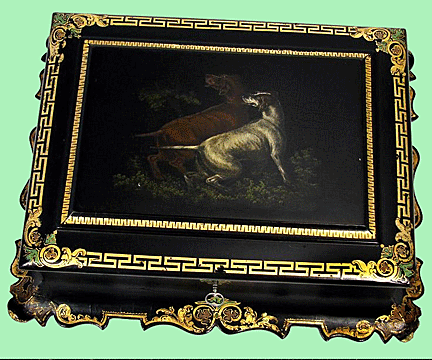 Japanning
is a British imitation of Oriental lacquer, pioneered by Henry Clay. He
dissolved resin in alcohol, then added sizing from boiled parchment
along with a whitening material. He applied this to a wooden base, then
polished and decorated the surface.. Japanning
is a British imitation of Oriental lacquer, pioneered by Henry Clay. He
dissolved resin in alcohol, then added sizing from boiled parchment
along with a whitening material. He applied this to a wooden base, then
polished and decorated the surface..
From the beginning, makers of papier-maché housewares japanned them. At
first the decoration was simple, with a black or red ground embellished
with a guilt border. But in the 1790's, they began to decorate the
entire surface. Not surprisingly, Chinese scenes were popular.
Decoration
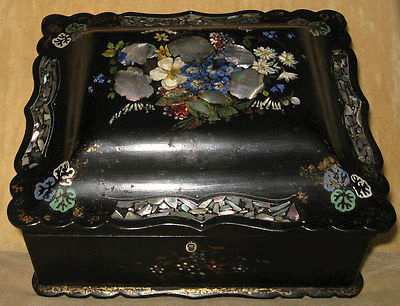 During
its early days, makers of papier-maché items decorated them with metal
powders and alloys, applying them with a swab, rather than a brush.
Typically, most pieces have a painted floral decoration on a black
ground, a characteristic look of Victorian papier-mâché, During
its early days, makers of papier-maché items decorated them with metal
powders and alloys, applying them with a swab, rather than a brush.
Typically, most pieces have a painted floral decoration on a black
ground, a characteristic look of Victorian papier-mâché,
Jennens and Bettridge changed the way they decorated their papier-maché,
especially with the extensive use of mother-of-pearl as an in-lay
material. Inlaid mother-of-pearl then became the most popular method of
decorating papier-maché items, along with painting and gliding.
Mother-of-pearl is an iridescent material that lines the shells of some
mollusks. The main sources are the pearl oyster found in the tropical
seas of the Far East, the freshwater pearl mussel from the United States
and European rivers and the abalone from the Pacific Ocean. At first,
workers painstakenly cut the mother-of-pearl into various shapes and
sanded them smooth until paper thin. They then cemented them into place.
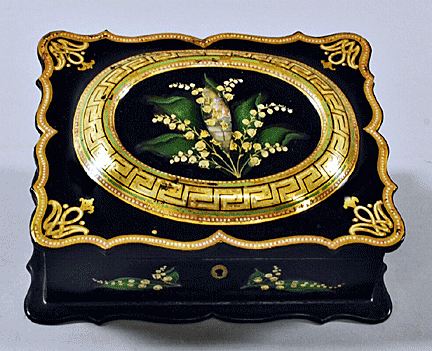 In
1825, Jennens and Bettridge received a patent for improvements in the
process of mother-of-pearl decoration. Their process by-passed the need
for skilled craftsmen to inlay decoration. Workers ground and polished
the mother-of-pearl pieces to a thickness of 0.2-0.4 mm. They then
stenciled these thin sheets of material with asphaltum and dipped them
hydrochloric acid. The acid dissolved all the shell not protected by the
asphaltum, leaving pearl pieces corresponding in size and shape to the
stencil pattern. As soon as the japanned surface had been varnished,
workers adhered the pieces to it, using the tacky varnish as the
adhesive. They then coated the areas of decoration repeatedly with
varnish and polished it until the surface was completely smooth, giving
the appearance of intricate inlay produced by skilled craftsmen. In
1825, Jennens and Bettridge received a patent for improvements in the
process of mother-of-pearl decoration. Their process by-passed the need
for skilled craftsmen to inlay decoration. Workers ground and polished
the mother-of-pearl pieces to a thickness of 0.2-0.4 mm. They then
stenciled these thin sheets of material with asphaltum and dipped them
hydrochloric acid. The acid dissolved all the shell not protected by the
asphaltum, leaving pearl pieces corresponding in size and shape to the
stencil pattern. As soon as the japanned surface had been varnished,
workers adhered the pieces to it, using the tacky varnish as the
adhesive. They then coated the areas of decoration repeatedly with
varnish and polished it until the surface was completely smooth, giving
the appearance of intricate inlay produced by skilled craftsmen.
Manufacturers used many subjects for decoration, such as landscapes,
flower designs, animals and insects. Geometric motifs were also very
popular. Artists hand-painted miniature portraits and pictures of
castles and famous buildings on some pieces of papier-maché, especially
small snuff boxes.
Decorations varied almost as much as the many articles made from
papier-maché. Not all papier-maché was made in black, although it
appears to be the most common color. Some papier-maché items had green,
red or yellow backgrounds, but these are hard to find today.
A Variety of Products
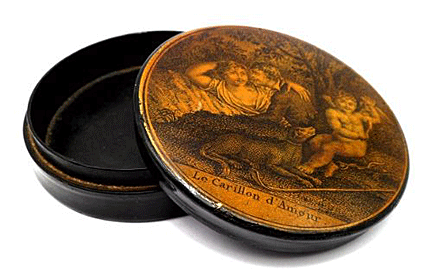 One
of the earliest and most popular papier-maché items was the snuff box.
The habit of taking snuff began in England in the 17th century and by
the beginning of the 18th century over 7,000 shops in London sold snuff. One
of the earliest and most popular papier-maché items was the snuff box.
The habit of taking snuff began in England in the 17th century and by
the beginning of the 18th century over 7,000 shops in London sold snuff.
Papier-maché was an ideal material for snuff boxes because it was cheap
and maintained the snuff at the correct humidity. The earliest boxes had
no rim, but makers added them later, making a frame for the decoration.
They were rectangular or circular in shape, and many snuff boxes had
hand-painted ' decoration, usually scenes from famous paintings. Top
quality ones came from the workshops of Samuel Raven, who signed most of
his work on the inside of the lid.
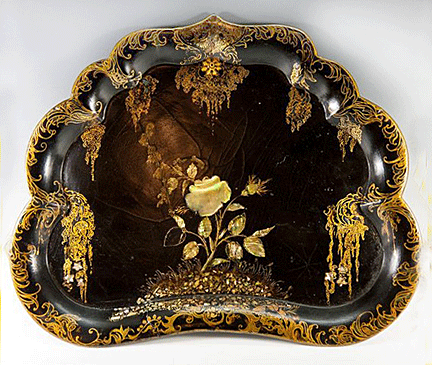 By
the late 18th century, papier-maché trays had become popular. Before
long, middle class families didn’t think their homes were complete
without a nest of papier-maché trays. Jennens and Bettridge presented a
set of three elaborately decorated trays to Queen Victoria on her
marriage to Albert in 1840. By
the late 18th century, papier-maché trays had become popular. Before
long, middle class families didn’t think their homes were complete
without a nest of papier-maché trays. Jennens and Bettridge presented a
set of three elaborately decorated trays to Queen Victoria on her
marriage to Albert in 1840.
The great interest in papier-maché trays resulted in the development of
new shapes with a variety of elaborate designs. Shapes were rectangular,
octagonal, oval and a form called Gothic. One variety of the Gothic,
known as the "parlor maid tray," had one side curved to fit the maid’s
waist for support when the tray was heavily laden with tea service
items. George Wallis of the Old Hall Works at Wolverhampton created an
oval scalloped tray which he called the "Victoria" in honor of the young
queen.
Letter writing was of great social importance during the Victorian
period, and a complete set of writing materials was provided in the
guest rooms of wealthy homes, often made of papier-maché. Lap desks were
popular with Victorian ladies. The writing board lifted up to expose
stationery and compartments for ink bottles, pen and postage stamps.
When the user closed the beautifully decorated cover, the compact lap
desk could be kept anywhere as a decorative piece.
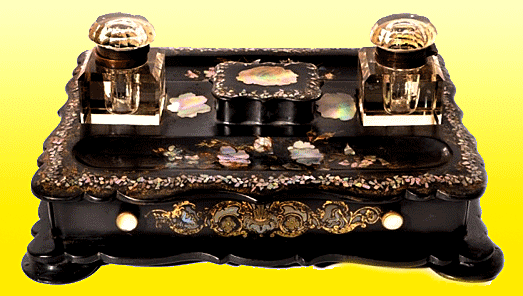
Inkstands were also frequently made of papier-maché. They usually had a
box for sealing wax placed between two crystal ink bottles with a slot
for pens in front. Other papier-maché items used for letter writing were
blotters, desk-folio's and letter racks.
 In
addition to producing decorated papier-maché products, some firms sold
blanks to outside decorators. One of the most famous, Samuel Raven,
specialized in snuff and tobacco boxes during the first three decades of
the 19th century. Amateurs also took up the craft, and it became a
popular hobby for English ladies during the 18th and 19th centuries. In
addition to producing decorated papier-maché products, some firms sold
blanks to outside decorators. One of the most famous, Samuel Raven,
specialized in snuff and tobacco boxes during the first three decades of
the 19th century. Amateurs also took up the craft, and it became a
popular hobby for English ladies during the 18th and 19th centuries.
Jennens and Bettridge also exported their products to America. In 1850
the Litchfield Manufacturing Company in Litchfield, Connecticut, began
producing large quantities of papier-maché, becoming known for its
daguerreotype cases, as well as some exquisite clock cases. Their firm's
characteristic design was a single rose with hand-painted leaves and
stems.
Papier-maché Furniture
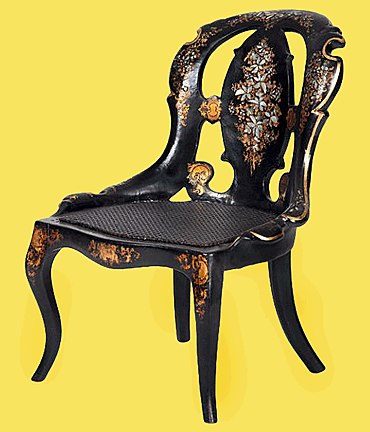 Papier-maché
cabinets, made to serve the dual purpose of holding both writing and
sewing materials, opened on top to display a satin or velvet-lined
interior in which ivory or mother-of-pearl sewing tools were kept. Two
doors in front covered small drawers made for writing supplies. Papier-maché
cabinets, made to serve the dual purpose of holding both writing and
sewing materials, opened on top to display a satin or velvet-lined
interior in which ivory or mother-of-pearl sewing tools were kept. Two
doors in front covered small drawers made for writing supplies.
While some furniture makers made their pieces entirely of papier-maché,
Jennens and Bettridge, however, found their pieces would be more durable
if they combined the papier-maché with wood or iron. Although quite rare
today, tables, chairs, beds, wardrobes, cabinets and even piano casings
can be found made from papier-maché. The papier-maché cabinet desk was
especially popular with women.
Jennens and Bettridge also produced a variety of other items from
papier-maché, such as fireplace screens and fans, used to protect the
ladies delicate complexion from a blast of heat from the open fire.
These panels came in pairs and often had elaborate shapes. Fans came
mounted on ivory, ebony, or gilt-wood sticks.
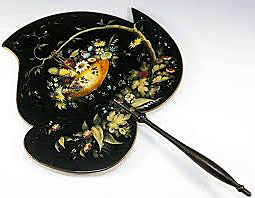 Papier-maché
items also graced the Victorian table. One of the most unique, called a
"voider," was a japanned basket into which servants placed dirty plates
and silverware after each dinner course. Papier-maché
items also graced the Victorian table. One of the most unique, called a
"voider," was a japanned basket into which servants placed dirty plates
and silverware after each dinner course.
Papier-maché calling card cases appeared as early as 1826, becoming more
popular later in the 19th century. While some had hinged lids, others
came in the folio style, both lined with silk or velvet to keep the
cards clean and smooth.
Papier-maché products retained their popularity from 1830 to 1860. As
the center of trade shifted from Birmingham to London, the quality
declined. By the last quarter of the 19th century, many items of
papier-maché were gaudy and displayed shoddy workmanship, causing its
popularity to decline.
< Back
to Collectibles Archives Next
Article >
|
